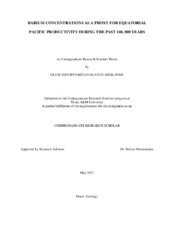| dc.description.abstract | The accumulation of biogenic sediments in the deep ocean may yield important information about past ocean productivity and its relationship to climate change. Sediments, sampled at approximately millennial resolution, every 4 – 5 cm on average, were obtained from a core (ML1208-17PC) retrieved from the Central Equatorial Pacific (CEP) ocean (0.48°N,156.45°W; water depth 2,926 m). The main objectives of this research were to (1) use barium concentrations in marine sediments as a proxy for past ocean export production, and to (2) determine how past glacial-interglacial changes in productivity are related to climate and, specifically, variability of dust fluxes which, in turn, are a function of changing atmospheric circulation patterns. Ba concentrations on complete digestions of bulk sediment were measured by inductively-coupled plasma mass spectrometry. Sediments ranging in age from late Holocene to 140 kyr yielded bulk barium concentrations that ranged from about 305 to 670 ppm. The authigenically-derived portion of the total barium, thought to be correlated with export production, is denoted as the biogenically-derived barium (bioBa). Using accumulation rates derived by Jacobel et al. (2017), we found bioBa accumulation rates that ranged from about 0.5 to 1.0 mg cm-2 kyr-1. For this research, the following hypotheses were tested:
1.) BioBa fluxes (i.e., productivity) will be higher at the equatorial site, during the last glacial maximum (Marine oxygen Isotope stage 2 (MIS 2); i.e. 25 – 12 kyr), than the same fluxes during the MIS 1 (i.e., 12 – 0 kyr).
2.) BioBa fluxes (i.e. productivity) will be higher during glacial MIS 4 and MIS 6 than those during interglacial MIS 3 and MIS 5.
Over the past 140 kyr, there is a positive relationship between productivity and warm interglacial periods which, in turn, are anti-correlated with dust fluxes determined by Jacobel et al. (2017). Thus, high bioBa accumulation rates correspond to less dusty warm periods, and vice versa. Productivity is apparently not a function of dust fertilization in the central equatorial Pacific, on Milankovitch glacial-interglacial timescales. | en |


